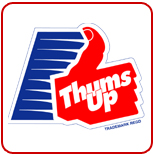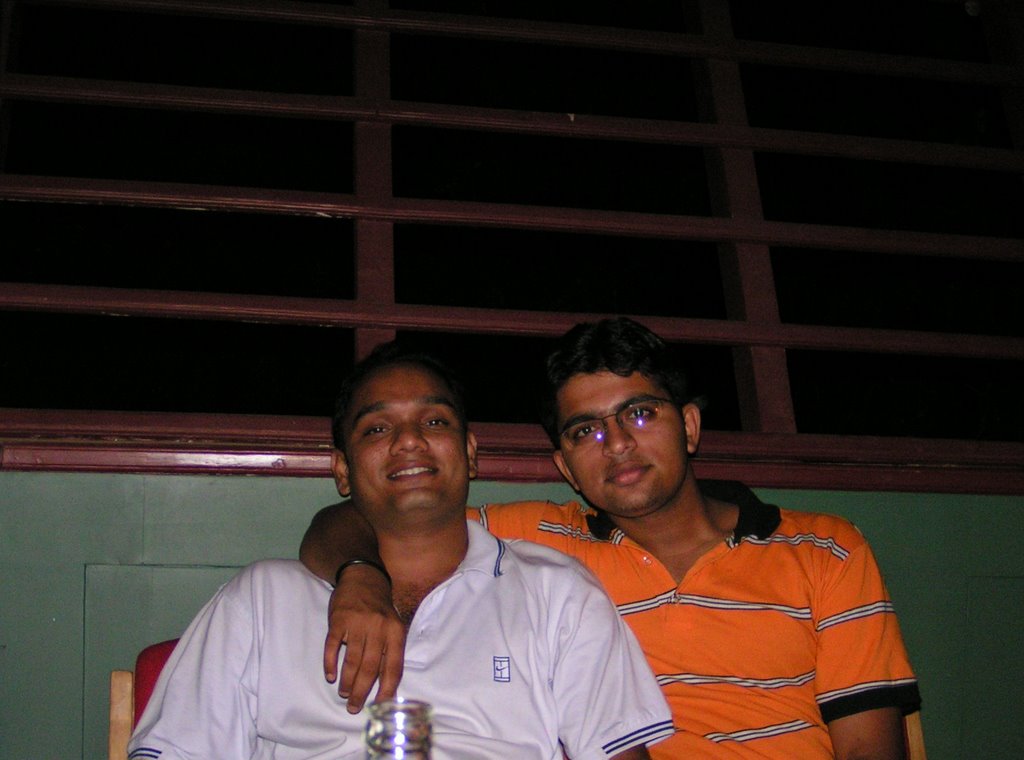Thums Up: Tasted Several Thunders!!
 Think of one of the Iconic brands of India and for most people the first brand that comes to mind is THUMS UP, it’s a brand that practically most of us have grown up with. The “killing” of Thums Up one of the most discussed case studies B-Schools across India. Surely this mite seem like a long article but rest assured.. ITS WELL WORTH A READ!!
Think of one of the Iconic brands of India and for most people the first brand that comes to mind is THUMS UP, it’s a brand that practically most of us have grown up with. The “killing” of Thums Up one of the most discussed case studies B-Schools across India. Surely this mite seem like a long article but rest assured.. ITS WELL WORTH A READ!!During late 1970s, the American cola giant Coca-Cola was shown the door by the Indian government. Following this, the Parle brothers, Ramesh Chauvan and Rajesh Chauvan, floated Parle soft drinks with Thums Up as their flagship drink along with Limca (lime flavour) and Gold Spot (orange flavored). Thums Up was basically a cola drink, but the company never claimed as such, and it tasted a bit stronger than regular Coke. During the same time, the owners of Coca-Cola’s bottling plant, Pure Drinks Ltd., launched Campa Cola and Campa Orange, both of which had a higher dose of carbon dioxide.
LOGO
The Thums Up logo was a clipart of a red thumbs-up sign with a slanted white serif typeface. Coca-Cola would later modified this with blue strokes and a more modern-looking typeface. This was mainly done to reduce the dominant red color in their signage.
Its famous caption until the early `80s was, “Happy days are here again”, coined by then famous copywriter Vasant Kumar, whose father was none other than spiritual philosopher U. G. Krishnamurti. Later it was changed to "Taste the thunder!" .
The Thums Up logo was a clipart of a red thumbs-up sign with a slanted white serif typeface. Coca-Cola would later modified this with blue strokes and a more modern-looking typeface. This was mainly done to reduce the dominant red color in their signage.
Its famous caption until the early `80s was, “Happy days are here again”, coined by then famous copywriter Vasant Kumar, whose father was none other than spiritual philosopher U. G. Krishnamurti. Later it was changed to "Taste the thunder!" .
COCA-COLA: The proud new owner
In 1993 Coca-Cola re-entered India after prolonged absences from 1977 to 1993. But Coca-Cola’s entry , made things even more complicated and the fight became a three-way battle. That same year, in a move that baffled many, Parle sold out to Coke for a meagre US$ 60 million (considering the Market share it had). Some assumed Parle had lost the appetite for a fight against the two largest cola brands; others surmised that the international brands seemingly endless cash reserves psyched-out Parle. Either way, it was now Coca-Cola’s, and Coke has a habit of killing brands in its portfolio that might overshadow it. Coca-Cola soon introduced its cola in Tins which was all India rage, with Thums Up introduced along side albeit minuscule numbers. Later Coca-Cola started pulling out the Thums Up brand which at that time still had more than 30% market share. Still, despite its strong overall equity, the brand was losing its popularity among the core cola drinking age group of 12 to 25 year olds, the Cartoon network generation, partly due to nil advertising and Coca-Cola’s initial brand killing efforts. Coca-Cola apparently did try to kill Thums Up, but soon realized that Pepsi would benefit more than Coke if Thums Up was withdrawn from the market. Instead, Coke decided to use Thums Up to attack Pepsi. The Coca-Cola Company by this time had about 60.5% share of the Indian soft-drink market [1] but much to its dismay found out that if it takes out Thums Up, it would remain with only 28.72% of the market (according to a report by NGO Finance&Trade in India), hence again dusted out the Thums Up brand and re-launched targeting the 30 to 45 year olds (probably its old fans who were peeved by both Pepsi and Coke).
The brand was re-positioned as a “manly” drink, drawing on its strong taste qualities. Known to be a strong drink with more power packed into it than other colas, it was a favourite in Rum based Cocktails and the byword “rum and Thums Up.” Hence Thums Up kick-started an aggressive campaign directly attacking Pepsi’s television advertisement, focussing on the strength of the drink hoping that the depiction of “adult” drink would appeal to young consumers. “Grow up to Thums Up” was a successful campaign. The brand’s market share and equity soared northwards. The brand was unshakeable and Coca-Cola’s declaration that Thums Up was India’s premier cola brand in terms of market share did not surprise many. Other campaigns from Thums Up’s build on the “strength” of its cola and build associations as a macho drink. Ads showing the Thums Up man riding through the desert in search of a cantina that sells Thums Up rather than drink another cola stick in the minds of many Indians and caught the imagination of youngsters who want to be seen as men. From a brand that was virtually unchallenged to a brand that was stifled, Thums Up stormed back after a near death experience.
In 1993 Coca-Cola re-entered India after prolonged absences from 1977 to 1993. But Coca-Cola’s entry , made things even more complicated and the fight became a three-way battle. That same year, in a move that baffled many, Parle sold out to Coke for a meagre US$ 60 million (considering the Market share it had). Some assumed Parle had lost the appetite for a fight against the two largest cola brands; others surmised that the international brands seemingly endless cash reserves psyched-out Parle. Either way, it was now Coca-Cola’s, and Coke has a habit of killing brands in its portfolio that might overshadow it. Coca-Cola soon introduced its cola in Tins which was all India rage, with Thums Up introduced along side albeit minuscule numbers. Later Coca-Cola started pulling out the Thums Up brand which at that time still had more than 30% market share. Still, despite its strong overall equity, the brand was losing its popularity among the core cola drinking age group of 12 to 25 year olds, the Cartoon network generation, partly due to nil advertising and Coca-Cola’s initial brand killing efforts. Coca-Cola apparently did try to kill Thums Up, but soon realized that Pepsi would benefit more than Coke if Thums Up was withdrawn from the market. Instead, Coke decided to use Thums Up to attack Pepsi. The Coca-Cola Company by this time had about 60.5% share of the Indian soft-drink market [1] but much to its dismay found out that if it takes out Thums Up, it would remain with only 28.72% of the market (according to a report by NGO Finance&Trade in India), hence again dusted out the Thums Up brand and re-launched targeting the 30 to 45 year olds (probably its old fans who were peeved by both Pepsi and Coke).
The brand was re-positioned as a “manly” drink, drawing on its strong taste qualities. Known to be a strong drink with more power packed into it than other colas, it was a favourite in Rum based Cocktails and the byword “rum and Thums Up.” Hence Thums Up kick-started an aggressive campaign directly attacking Pepsi’s television advertisement, focussing on the strength of the drink hoping that the depiction of “adult” drink would appeal to young consumers. “Grow up to Thums Up” was a successful campaign. The brand’s market share and equity soared northwards. The brand was unshakeable and Coca-Cola’s declaration that Thums Up was India’s premier cola brand in terms of market share did not surprise many. Other campaigns from Thums Up’s build on the “strength” of its cola and build associations as a macho drink. Ads showing the Thums Up man riding through the desert in search of a cantina that sells Thums Up rather than drink another cola stick in the minds of many Indians and caught the imagination of youngsters who want to be seen as men. From a brand that was virtually unchallenged to a brand that was stifled, Thums Up stormed back after a near death experience.
The brand proves that its strength lies not just in its taste but also in its performance. The grown up tag is an enduring one and will probably counter Pepsi for a while to come. Looking at the recent promotions for Thums Up I sure get the impression that it is overdone and also quite dull especially the one starring Kunal Kapoor..the ads of thums up surely lack the fizz of the early campaigns where although there was an element of hyperbole, the execution would be so good that it would sure grab some attention. Surely getting back the TASTE THE THUNDER campaign was a good move but surely I expected a much better execution for the ads and promotions... (the earlier ad featuring Akshay Kumar also lacked a good execution..just showing some stunts by a celebrity on screen doesnt mean that ur product wud sell)....im sure you guys are gonna pour in your views on the same..





![Validate my RSS feed [Valid RSS]](valid-rss.png)


3 Comments:
Thums UP story is as popular as any other brand's story... and why not? it is still one of the best brands...
i thought Akshay Kumar's TVC was up to the mark but the latest TVC featuring Kunal Kapoor lacks that macho look...
But Praveen, if u observe, there is a lot of change in a girl's "COOL GUY" perspective these days... she looks for atleast a little bit of so called "GIRLISH" trait in any man, and thts wat Kunal has executed superbly in the new TVC... Wat Say?
cheers
Chethan
well till now thumpsup has lived on the macho look , to me the best of thumsup ad was that of bungee jumping and the present one is bakhwas, one because of kunal kapoor second it looks very artificial more like a mountain dew ad..ahh and abt girls they would like to see 101 things in a cool guy than just the girlish trait...and we would like to see one thing in thumsup ie MACHO trait.
Interesting! I'm drinking from a bottle with the old logo now, wondering just how old this stuff is...
(That said, you need to come down on Wikipedia for plagiarizing your article, or vice versa. *grin*)
Post a Comment
<< Home